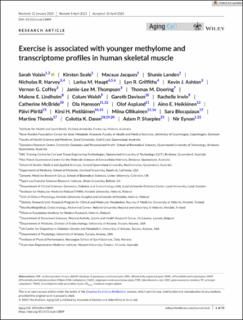| dc.contributor.author | Voisin, Sarah | |
| dc.contributor.author | Seale, Kirsten | |
| dc.contributor.author | Jacques, Macsue | |
| dc.contributor.author | Landen, Shanie | |
| dc.contributor.author | Coffey, Vernon G. | |
| dc.contributor.author | Walsh, Colum | |
| dc.contributor.author | Davison, Gareth | |
| dc.contributor.author | McBride, Catherine | |
| dc.contributor.author | Irwin, Rachelle | |
| dc.contributor.author | Hansson, Ola | |
| dc.contributor.author | Asplund, Olof | |
| dc.contributor.author | Harvey, Nicholas R. | |
| dc.contributor.author | Haupt, Larisa M. | |
| dc.contributor.author | Griffiths, Lyn R. | |
| dc.contributor.author | Ashton, Kevin J. | |
| dc.contributor.author | Thompson, Jamie-Lee M. | |
| dc.contributor.author | Doering, Thomas M. | |
| dc.contributor.author | Lindholm, Maléne E. | |
| dc.contributor.author | Sharples, Adam P. | |
| dc.contributor.author | Eynon, Nir | |
| dc.date.accessioned | 2023-10-12T13:33:58Z | |
| dc.date.available | 2023-10-12T13:33:58Z | |
| dc.date.created | 2023-03-08T15:14:07Z | |
| dc.date.issued | 2023 | |
| dc.identifier.citation | Aging Cell. 2023, Artikkel e13859. | en_US |
| dc.identifier.issn | 1474-9718 | |
| dc.identifier.uri | https://hdl.handle.net/11250/3096174 | |
| dc.description | This is an open access article under the terms of the Creative Commons Attribution License, which permits use, distribution and reproduction in any medium, provided the original work is properly cited. | en_US |
| dc.description.abstract | Exercise training prevents age-related decline in muscle function. Targeting epigenetic aging is a promising actionable mechanism and late-life exercise mitigates epigenetic aging in rodent muscle. Whether exercise training can decelerate, or reverse epigenetic aging in humans is unknown. Here, we performed a powerful meta-analysis of the methylome and transcriptome of an unprecedented number of human skeletal muscle samples (n = 3176). We show that: (1) individuals with higher baseline aerobic fitness have younger epigenetic and transcriptomic profiles, (2) exercise training leads to significant shifts of epigenetic and transcriptomic patterns toward a younger profile, and (3) muscle disuse “ages” the transcriptome. Higher fitness levels were associated with attenuated differential methylation and transcription during aging. Furthermore, both epigenetic and transcriptomic profiles shifted toward a younger state after exercise training interventions, while the transcriptome shifted toward an older state after forced muscle disuse. We demonstrate that exercise training targets many of the age-related transcripts and DNA methylation loci to maintain younger methylome and transcriptome profiles, specifically in genes related to muscle structure, metabolism, and mitochondrial function. Our comprehensive analysis will inform future studies aiming to identify the best combination of therapeutics and exercise regimes to optimize longevity. | en_US |
| dc.language.iso | eng | en_US |
| dc.relation.uri | https://onlinelibrary.wiley.com/doi/10.1111/acel.13859 | |
| dc.subject | aging | en_US |
| dc.subject | cardiorespiratory fitness | en_US |
| dc.subject | DNA methylation | en_US |
| dc.subject | exercise training | en_US |
| dc.subject | human skeletal muscle | en_US |
| dc.subject | meta-analysis | en_US |
| dc.subject | mRNA expression | en_US |
| dc.title | Exercise is associated with younger methylome and transcriptome profiles in human skeletal muscle | en_US |
| dc.type | Peer reviewed | en_US |
| dc.type | Journal article | en_US |
| dc.description.version | publishedVersion | en_US |
| dc.rights.holder | © 2023 The Authors | en_US |
| dc.source.pagenumber | 15 | en_US |
| dc.source.journal | Aging Cell | en_US |
| dc.identifier.doi | 10.1111/acel.13859 | |
| dc.identifier.cristin | 2132458 | |
| dc.description.localcode | Institutt for fysisk prestasjonsevne / Department of Physical Performance | en_US |
| dc.source.articlenumber | e13859 | en_US |
| cristin.ispublished | true | |
| cristin.fulltext | original | |
| cristin.qualitycode | 1 | |
